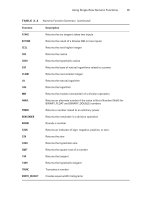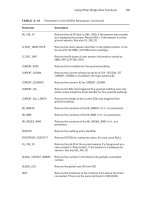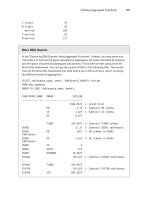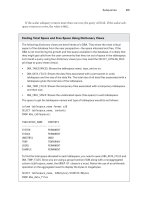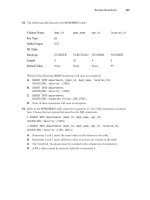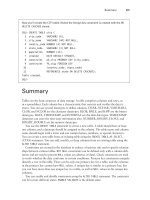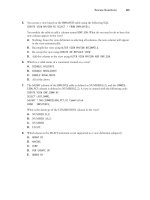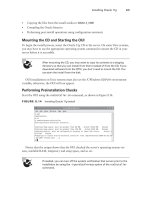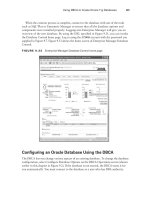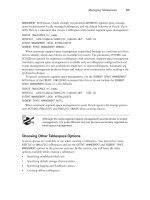Tài liệu OCA: Oracle Database 11g Administrator Certified Associate- P6 pptx
Bạn đang xem bản rút gọn của tài liệu. Xem và tải ngay bản đầy đủ của tài liệu tại đây (650.3 KB, 50 trang )
Utilizing Aggregate Functions
181
F single 47
M single 92
married 180
F married 63
M married 117
More DBA Queries
In the “Exploring DBA Queries Using Aggregate Functions” sidebar, you saw some que-
ries written to find out the space allocated by tablespace, the space allocated by schema,
and the space allocated by tablespace and schema. These were written using three dif-
ferent SQL statements. You can see the power of
CUBE
in the following SQL. The results
from all the three SQL statements you tried before are in this summary report, showing
the different levels of aggregation.
SELECT tablespace_name, owner, SUM(bytes)/1048576 size_mb
FROM dba_segments
GROUP BY CUBE (tablespace_name, owner);
TABLESPACE_NAME OWNER SIZE_MB
----------------- --------------- ----------
1564.8125 <- Grand Total
HR 1.75 <- Subtotal HR schema
IX 1.625 <- Subtotal IX schema
OE 8.875
… … …
FLOWS 100.6875 <- Subtotal FLOWS schema
USERS 21.25 <- Subtotal USERS tablespace
USERS HR .1875 <- HR schema in USERS
tablespace
USERS OE 2.625 <- OE schema in USERS
tablespace
USERS SH 2
USERS SCOTT .375
USERS BTHOMAS 16.0625
SYSAUX 716.375 <- Subtotal SYSAUX tablespace
… … …
SYSAUX FLOWS 100.6875
SYSTEM 701.625 <- Subtotal SYSTEM tablespace
SYSTEM SYS 685.1875
95127c03.indd 181 2/17/09 11:38:12 AM
Please purchase PDF Split-Merge on www.verypdf.com to remove this watermark.
182
Chapter 3
N
Using Group Functions
SYSTEM OUTLN .5625
SYSTEM SYSTEM 15.875
EXAMPLE 77.3125
EXAMPLE HR 1.5625
… … …
As you can see in the result, the space used by each schema in each tablespace is shown
as well as the total space used in each tablespace and the total space used by each schema.
The total space used in the database (including all tablespaces) is also shown in the very
first line.
Three functions come in handy with the
ROLLUP
and
CUBE
modifiers of the
GROUP BY
clause—
GROUPING
,
GROUP_ID
, and
GROUPING_ID
.
In the examples you have seen using the
ROLLUP
and
CUBE
modifiers, there was no way
of telling which row is a subtotal and which row is a grand total. You can use the
GROUPING
function to overcome this problem. Review the following SQL example:
SELECT gender, marital_status, count(*) num_rec,
GROUPING (gender) g_grp, GROUPING (marital_status) ms_grp
FROM oe.customers
GROUP BY CUBE(marital_status, gender);
G MARITAL_STATUS NUM_REC G_GRP MS_GRP
- -------------------- ---------- ---------- ----------
319 1 1
F 110 0 1
M 209 0 1
single 139 1 0
F single 47 0 0
M single 92 0 0
married 180 1 0
F married 63 0 0
M married 117 0 0
The
G_GRP
column has a 1 for
NULL
values generated by the
CUBE
or
ROLLUP
modifier for
GENDER
column. Similarly, the
MS_GRP
column has a 1 when
NULL
values are generated in the
MARITAL_STATUS
column. Using a
DECODE
function on the result of the
GROUPING
function,
you can produce a more meaningful result set, as in the following example:
SELECT DECODE(GROUPING (gender), 1, ‘Multi-Gender’,
gender) gender,
DECODE(GROUPING (marital_status), 1,
95127c03.indd 182 2/17/09 11:38:12 AM
Please purchase PDF Split-Merge on www.verypdf.com to remove this watermark.
Utilizing Aggregate Functions
183
‘Multi-MaritalStatus’, marital_status) marital_status,
count(*) num_rec
FROM oe.customers
GROUP BY CUBE(marital_status, gender);
GENDER MARITAL_STATUS NUM_REC
------------ -------------------- ----------
Multi-Gender Multi-MaritalStatus 319
F Multi-MaritalStatus 110
M Multi-MaritalStatus 209
Multi-Gender single 139
F single 47
M single 92
Multi-Gender married 180
F married 63
M married 117
You can use the
GROUPING
function in the
HAVING
clause to filter out rows. You
can display only the summary results using the
GROUPING
function in the
HAVING
clause.
The
GROUPING_ID
function returns the exact level of the group. It is derived from the
GROUPING
function by concatenating the
GROUPING
levels together as bits, and gives
the
GROUPING_ID
. Review the following example closely to understand this:
SELECT gender, marital_status, count(*) num_rec,
GROUPING (gender) g_grp, GROUPING (marital_status) ms_grp,
GROUPING_ID (gender, marital_status) groupingid
FROM oe.customers
GROUP BY CUBE(gender, marital_status);
G MARITAL_STATUS NUM_REC G_GRP MS_GRP GROUPINGID
- -------------------- ---------- ---------- ---------- ----------
319 1 1 3
single 139 1 0 2
married 180 1 0 2
F 110 0 1 1
F single 47 0 0 0
F married 63 0 0 0
M 209 0 1 1
M single 92 0 0 0
M married 117 0 0 0
95127c03.indd 183 2/17/09 11:38:12 AM
Please purchase PDF Split-Merge on www.verypdf.com to remove this watermark.
184
Chapter 3
N
Using Group Functions
In this example, you can clearly identify the level of grouping using the
GROUPING_ID
function. The
GROUP_ID
function is used to distinguish the duplicate groups. In the follow-
ing example, the
GROUP_ID()
value is 1 for duplicate groups. When writing complex aggre-
gates, you can filter out the duplicate rows by using the
HAVING GROUP_ID = 0
clause in the
SELECT
statement.
SELECT gender, marital_status, count(*) num_rec,
GROUPING_ID (gender, marital_status) groupingid,
GROUP_ID() groupid
FROM oe.customers
GROUP BY gender, CUBE(gender, marital_status);
G MARITAL_STATUS NUM_REC GROUPINGID GROUPID
- -------------------- ---------- ---------- ----------
F single 47 0 0
F married 63 0 0
M single 92 0 0
M married 117 0 0
F single 47 0 1
F married 63 0 1
M single 92 0 1
M married 117 0 1
F 110 1 0
M 209 1 0
F 110 1 1
M 209 1 1
Nesting Functions
Functions can be nested so that the output from one function is used as input to another.
Operators have an inherent precedence of execution such as
*
before
+
, but function
precedence is based on position only. Functions are evaluated innermost to outermost
and left to right. This nesting technique is common with some functions, such as
DECODE
(covered in Chapter 2), where it can be used to implement limited
IF…THEN…ELSE
logic
within a SQL statement.
For example, the
V$SYSSTAT
view contains one row for each of three interesting sort
statistics. If you want to report all three statistics on a single line, you can use
DECODE
com-
bined with
SUM
to filter out data in the
SELECT
clause. This filtering operation is usually
done in the
WHERE
or
HAVING
clause, but if you want all three statistics on one line, you can
issue this command:
SELECT SUM (DECODE
(name,’sorts (memory)’,value,0)) in_memory,
95127c03.indd 184 2/17/09 11:38:12 AM
Please purchase PDF Split-Merge on www.verypdf.com to remove this watermark.
Utilizing Aggregate Functions
185
SUM (DECODE
(name,’sorts (disk)’, value,0)) on_disk,
SUM (DECODE
(name,’sorts (rows)’, value,0)) rows_sorted
FROM v$sysstat;
IN_MEMORY ON_DISK ROWS_SORTED
--------- ------- -----------
728 12 326714
What happens in the previous statement is a single pass through the
V$SYSSTAT
table.
The presummary result set would have the same number of rows as
V$SYSSTAT
(232, for
instance). Of these 232 rows, all rows and columns have zeros, except for one row in each
column that has the data of interest. Table 3.3 shows the data that was used in this example.
The summation operation then adds all the zeros to your interesting data and gives you the
results you want.
TABLE 3.3 Presummarized Result Set
in_memory on_disk rows_sorted
0 0 0
0 12 0
0 0 0
0 0 326714
728 0 0
0 0 0
Nesting Single-Row Functions with Group Functions
Nested functions can include single-row functions nested within group functions, as you’ve
just seen, or group functions nested within either single-row functions or other group func-
tions. For example, suppose you need to report on the departments in the
EMP
table, show-
ing either the number of jobs or the number of managers, whichever is greater. You would
enter the following:
SELECT deptno, GREATEST(
COUNT(DISTINCT job),
COUNT(DISTINCT mgr)) cnt,
COUNT(DISTINCT job) jobs,
95127c03.indd 185 2/17/09 11:38:12 AM
Please purchase PDF Split-Merge on www.verypdf.com to remove this watermark.
186
Chapter 3
N
Using Group Functions
COUNT(DISTINCT mgr) mgrs
FROM scott.emp
GROUP BY deptno;
DEPTNO CNT JOBS MGRS
---------- ---------- ---------- ----------
10 3 3 2
20 4 3 4
30 3 3 2
Nesting Group Functions
You can also nest group functions within group functions. Only one level of nesting is
allowed when nesting a group function within a group function. To report the maximum
number of jobs in a single department, you would query the following:
SELECT MAX(COUNT (DISTINCT job_id))
FROM employees
GROUP BY department_id;
MAX(COUNT(DISTINCTJOB_ID))
--------------------------
3
Group functions can be nested only one level. If you try to nest more than one level of
nested group functions, you will encounter an error. Also, there is no reason to do so. Here
is an example to show the error, though the SQL does not mean much:
SELECT MIN (MAX (COUNT (DISTINCT job_id)))
FROM employees
GROUP BY department_id;
SELECT MIN (MAX (COUNT (DISTINCT job_id)))
*
ERROR at line 1:
ORA-00935: group function is nested too deeply
95127c03.indd 186 2/17/09 11:38:12 AM
Please purchase PDF Split-Merge on www.verypdf.com to remove this watermark.
Exam Essentials
187
Summary
Though this chapter is small in terms of OCA certification exam content, this chapter is very
important for the test. It is important to understand the concept of grouping data, where
GROUP BY
and
HAVING
clauses can be used, and the rules associated with using these clauses.
I started this chapter by discussing the group-function fundamentals and reviewed the group
functions by concentrating on the functions that are important for the test.
I also discussed how group functions can be used in the
SELECT
,
HAVING
, and
ORDER BY
clauses of
SELECT
statements. Most group functions can be applied to all data values or
only to the distinct data values. Except for
COUNT(*)
, group functions ignore
NULL
s. Pro-
grammer-written functions cannot be used as group functions.
COUNT
,
SUM
, and
AVG
are the
most commonly used group functions.
When using group functions or aggregate functions in a query, the columns that do not
have any aggregate function applied to them must appear in the
GROUP BY
clause of the query.
The
HAVING
clause is used to filter out data after the aggregates are calculated. Group func-
tions cannot be used in the
WHERE
clause.
You can create superaggregates using the
CUBE
and
ROLLUP
modifiers in the
GROUP BY
clause.
Exam Essentials
Understand the usage of
DISTINCT
in group functions. When
DISTINCT
is specified, only
one of each non-
NULL
value is applied to the function. To apply all non-
NULL
values, the
keyword
ALL
should be used.
Know where group functions can be used. Group functions can be used in
GROUP BY
,
ORDER BY
, and
HAVING
clauses. They cannot be used in
WHERE
clauses.
Know how
MIN
and
MAX
sort date and character data. Older dates evaluate to lower values,
while newer dates evaluate to higher values. Character data, even if it contains numbers, is
sorted according to the
NLS_SORT
specification.
Know which expressions in a
SELECT
list must appear in a
GROUP BY
clause. If any group-
ing is performed, all nongroup function expressions and nonconstant expressions must
appear in the
GROUP BY
clause.
Know the order of precedence for evaluating nested functions. You may need to evalu-
ate an expression containing nested functions. Make sure you understand the left-to-right
order of precedence used to evaluate these expressions.
95127c03.indd 187 2/17/09 11:38:12 AM
Please purchase PDF Split-Merge on www.verypdf.com to remove this watermark.
188
Review Questions
Review Questions
1. How will the results of the following two statements differ?
Statement 1:
SELECT MAX(longitude), MAX(latitude)
FROM zip_state_city;
Statement 2:
SELECT MAX(longitude), MAX(latitude)
FROM zip_state_city
GROUP BY state;
A. Statement 1 will fail because it is missing a GROUP BY clause.
B. Statement 2 will return one row, and statement 1 may return more than one row.
C. Statement 2 will fail because it does not have the columns used in the GROUP BY clause
in the SELECT clause.
D. Statement 1 will display two columns, and statement 2 will display two values for each
state.
2. Using the SALES table described here, you need to report the following:
Gross, net, and earned revenue for the second and third quarters of 1999
ÛN
Gross, net, and earned revenue for sales in the states of Illinois, California, and
ÛN
Texas (codes
IL
,
CA
, and
TX
)
Column Name
state_code sales_date gross net earned
Key Type PK PK
Nulls/Unique NN NN NN NN NN
FK Table
Datatype VARCHAR2 DATE NUMBER NUMBER NUMBER
Length 2 11,2 11,2 11,2
Will all the requirements be met with the following SQL statement?
SELECT state_code, SUM(ALL gross), SUM(net), SUM(earned)
FROM sales_detail
WHERE TRUNC(sales_date,’Q’) BETWEEN
TO_DATE(’01-Apr-1999’,’DD-Mon-YYYY’)
AND TO_DATE(’01-Sep-1999’,’DD-Mon-YYYY’)
AND state_cd IN (’IL’,’CA’,’TX’)
GROUP BY state_code;
95127c03.indd 188 2/17/09 11:38:13 AM
Please purchase PDF Split-Merge on www.verypdf.com to remove this watermark.
Review Questions
189
A. The statement meets all three requirements.
B. The statement meets two of the three requirements.
C. The statement meets one of the three requirements.
D. The statement meets none of the three requirements.
E. The statement will raise an exception.
3. Which line in the following SQL has an error?
1 SELECT department_id, SUM(salary)
2 FROM employees
3 WHERE department_id <> 40
4 ORDER BY department_id;
A. 1
B. 3
C. 4
D. No errors in SQL
4. John is trying to find out the average salary of employees in each department. He noticed
that the SALARY column can have NULL values, and he does not want the NULLs included
when calculating the average. Identify the correct SQL that will produce the desired results.
A. SELECT department_id, AVG(salary)
FROM employees
GROUP BY department_id;
B. SELECT department_id, AVG(NVL(salary,0))
FROM employees
GROUP BY department_id;
C. SELECT department_id, NVL(AVG(salary), 0)
FROM employees
GROUP BY department_id;
D. SELECT department_id, AVG(salary)
FROM employees
GROUP BY department_id
HAVING salary IS NOT NULL;
95127c03.indd 189 2/17/09 11:38:13 AM
Please purchase PDF Split-Merge on www.verypdf.com to remove this watermark.
190
Review Questions
5. Review the following two SQL statements, and choose the appropriate option.
1. SELECT department_id, COUNT(*)
FROM employees
HAVING COUNT(*) > 10
GROUP BY department_id;
2. SELECT department_id, COUNT(*)
FROM employees
WHERE COUNT(*) > 10
GROUP BY department_id;
A. Statement 1 and statement 2 will produce the same results.
B. Statement 1 will succeed, and statement 2 will fail.
C. Statement 2 will succeed, and statement 1 will fail.
D. Both statements fail.
6. Read the following SQL carefully, and choose the appropriate option. The JOB_ID column
shows the various jobs.
SELECT MAX(COUNT(*))
FROM employees
GROUP BY job_id, department_id;
A. Aggregate functions cannot be nested.
B. The columns in the GROUP BY clause must appear in the SELECT clause for the query
to work.
C. The GROUP BY clause is not required in this query.
D. The SQL will produce the highest number of jobs within a department.
7. Identify the SQL that produces the correct result.
A. SELECT department_id, SUM(salary)
FROM employees
WHERE department_id <> 50
GROUP BY department_id
HAVING COUNT(*) > 30;
B. SELECT department_id, SUM(salary) sum_sal
FROM employees
WHERE department_id <> 50
GROUP BY department_id
HAVING sum_sal > 3000;
95127c03.indd 190 2/17/09 11:38:13 AM
Please purchase PDF Split-Merge on www.verypdf.com to remove this watermark.
Review Questions
191
C. SELECT department_id, SUM(salary) sum_sal
FROM employees
WHERE department_id <> 50
AND sum_sal > 3000
GROUP BY department_id;
D. SELECT department_id, SUM(salary)
FROM employees
WHERE department_id <> 50
AND SUM(salary) > 3000
GROUP BY department_id;
8. Consider the following SQL, and choose the most appropriate option.
SELECT COUNT(DISTINCT SUBSTR(first_name, 1,1))
FROM employees;
A. A single-row function nested inside a group function is not allowed.
B. The GROUP BY clause is required to successfully run this query.
C. Removing the DISTINCT qualifier will fix the error in the query.
D. The query will execute successfully without any modification.
9. The sales order number (ORDER_NO) is the primary key in the table SALES_ORDERS. Which
query will return the total number of orders in the SALES_ORDERS table?
A. SELECT COUNT(ALL order_no) FROM sales_orders;
B. SELECT COUNT(DISTINCT order_no) FROM sales_orders;
C. SELECT COUNT(order_no) FROM sales_orders;
D. SELECT COUNT(NVL(order_no,0) FROM sales_orders;
E. All of the above
F. A and C
10. Sheila wants to find the highest salary within each department of the EMPLOYEES table.
Which query will help her get what she wants?
A. SELECT MAX(salary) FROM employees;
B. SELECT MAX(salary BY department_id) FROM employees;
C. SELECT department_id, MAX(salary) max_sal FROM employees;
D. SELECT department_id, MAX(salary) FROM employees GROUP BY department_
id;
E. SELECT department_id, MAX(salary) FROM employees USING department_id;
95127c03.indd 191 2/17/09 11:38:13 AM
Please purchase PDF Split-Merge on www.verypdf.com to remove this watermark.
192
Review Questions
11. Which assertion about the following queries is true?
SELECT COUNT(DISTINCT mgr), MAX(DISTINCT salary)
FROM emp;
SELECT COUNT(ALL mgr), MAX(ALL salary)
FROM emp;
A. They will always return the same numbers in columns 1 and 2.
B. They may return different numbers in column 1 but will always return the same num-
ber in column 2.
C. They may return different numbers in both columns 1 and 2.
D. They will always return the same number in column 1 but may return different num-
bers in column 2.
12. Which clauses in the SELECT statement can use single-row functions nested in aggregate
functions? (Choose all that apply.)
A. SELECT
B. ORDER BY
C. WHERE
D. GROUP BY
13. Consider the following two SQL statements. Choose the most appropriate option.
1.
select substr(first_name, 1,1) fn, SUM(salary) FROM employees GROUP BY
first_name;
2.
select substr(first_name, 1,1) fn, SUM(salary) FROM employees GROUP BY
substr(first_name, 1,1);
A. Statement 1 and 2 will produce the same result.
B. Statement 1 and 2 will produce different results.
C. Statement 1 will fail.
D. Statement 2 will fail, but statement 1 will succeed.
14. How will the results of the following two SQL statements differ?
Statement 1:
SELECT COUNT(*), SUM(salary)
FROM hr.employees;
Statement 2:
SELECT COUNT(salary), SUM(salary)
FROM hr.employees;
95127c03.indd 192 2/17/09 11:38:13 AM
Please purchase PDF Split-Merge on www.verypdf.com to remove this watermark.
Review Questions
193
A. Statement 1 will return one row, and statement 2 may return more than one row.
B. Both statements will fail because they are missing a GROUP BY clause.
C. Both statements will return the same results.
D. Statement 2 may return a smaller COUNT value than statement 1.
15. Why does the following SELECT statement fail?
SELECT colorname Colour, MAX(cost)
FROM itemdetail
WHERE UPPER(colorname) LIKE ‘%WHITE%’
GROUP BY colour
HAVING COUNT(*) > 20;
A. A GROUP BY clause cannot contain a column alias.
B. The condition COUNT(*) > 20 should be in the WHERE clause.
C. The GROUP BY clause must contain the group functions used in the SELECT list.
D. The HAVING clause can contain only the group functions used in the SELECT list.
16. What will the following SQL statement return?
select max(prod_pack_size)
from sh.products
where min(prod_weight_class) = 5;
A. An exception will be raised.
B. The largest PROD_PACK_SIZE for rows containing PROD_WEIGHT_CLASS of 5 or higher
C. The largest PROD_PACK_SIZE for rows containing PROD_WEIGHT_CLASS of 5
D. The largest PROD_PACK_SIZE in the SH.PRODUCTS table
17. Why will the following query raise an exception?
select dept_no, avg(distinct salary),
count(job) job_count
from emp
where mgr like ‘J%’
or abs(salary) > 10
having count(job) > 5
order by 2 desc;
A. The HAVING clause cannot contain a group function.
B. The GROUP BY clause is missing.
C. ABS() is not an Oracle function.
D. The query will not raise an exception.
95127c03.indd 193 2/17/09 11:38:13 AM
Please purchase PDF Split-Merge on www.verypdf.com to remove this watermark.
194
Review Questions
18. Which clause will generate an error when the following query is executed?
SELECT department_id, AVG(salary) avg_sal
FROM employees
GROUP BY department_id
HAVING TRUNC(department_id) > 50;
A. The GROUP BY clause, because it is missing the group function.
B. The HAVING clause, because single-row functions cannot be used.
C. The HAVING clause, because the AVG function used in the SELECT clause is not used in
the HAVING clause.
D. None of the above. The SQL statement will not return an error.
19. Which statements are true? (Choose all that apply.)
A. A group function can be used only if the GROUP BY clause is present.
B. Group functions along with nonaggregated columns can appear in the SELECT clause
as long as a GROUP BY clause and a HAVING clause are present.
C. The HAVING clause is optional when the GROUP BY clause is used.
D. The HAVING clause and the GROUP BY clause are mutually exclusive; you can use only
one clause in a SELECT statement.
20. Read the following two statements, and choose the best option.
1.
HAVING
clause should always appear after the
GROUP BY
clause.
2.
GROUP BY
clause should always appear after the
WHERE
clause.
A. Statement 1 and 2 are false.
B. Statement 1 is true, and statement 2 is false.
C. Statement 1 is false, and statement 2 is true.
D. Statements 1 and 2 are true.
95127c03.indd 194 2/17/09 11:38:13 AM
Please purchase PDF Split-Merge on www.verypdf.com to remove this watermark.
Answers to Review Questions
195
Answers to Review Questions
1. D. Though you do not have a state column in the SELECT clause, having it in the GROUP
BY clause will group the results by state, so you end up getting two values (two columns) for
each state.
2. A. All requirements are met. The gross-, net-, and earned-revenue requirements are satis-
fied with the SELECT clause. The second- and third-quarter sales requirement is satisfied
with the first predicate of the WHERE clause—the sales date will be truncated to the first day
of a quarter; thus, 01-Apr-1999 or 01-Jul-1999 for the required quarters (which are both
between 01-Apr-1999 and 01-Sep-1999). The state codes requirement is satisfied by the
second predicate in the WHERE clause. This question is intentionally misleading, but so are
some exam questions (and, unfortunately, some of the code in some shops).
3. C. Since the department_id column does not have any aggregate function applied to it,
it must appear in the GROUP BY clause. The ORDER BY clause in the SQL must be replaced
with a GROUP BY clause to make the query work.
4. A. Since group functions do not include NULL values in their calculation, you do not have to
do anything special to exclude the NULL values. Only COUNT(*) includes NULL values.
5. B. An aggregate function is not allowed in the WHERE clause. You can have the GROUP BY
and HAVING clauses in any order, but they must appear after the WHERE clause.
6. D. The SQL will work fine and produce the result. Since group functions are nested, a
GROUP BY clause is required.
7. A. It is perfectly alright to have one function in the SELECT clause and another function in
the HAVING clause of the query. Options B and C are trying to use the alias name, which is
not allowed. Option D has a group function in the WHERE clause, which is also not allowed.
8. D. The query will return how many distinct alphabets are used to begin names in the
EMPLOYEES table. You can nest a group function inside a single-row function, and vice versa.
9. E. All the queries will return the same result. Since ORDER_NO is the primary key, there cannot
be NULL values in the column. Hence, ALL and DISTINCT will give the same result.
10. D. Option A will display the highest salary of all the employees. Options B and E use
invalid syntax keywords. Option C does not have a GROUP BY clause.
11. B. The first column in the first query is counting the distinct MGR values in the table. The first
column in the second query is counting all MGR values in the table. If a manager appears twice,
the first query will count her one time, but the second will count her twice. Both the first query
and the second query are selecting the maximum salary value in the table.
12. A, B. A group function is not allowed in GROUP BY or WHERE clauses, whether you use it as
nested or not.
95127c03.indd 195 2/17/09 11:38:13 AM
Please purchase PDF Split-Merge on www.verypdf.com to remove this watermark.
196
Chapter 3
N
Using Group Functions
13. B. Both statements are valid. The first statement will produce the number of rows equal to
the number of unique first_name values. The second statement will produce the number of
rows equal to the unique number of first characters in the first_name column.
14. D. COUNT(*) will count all rows in the table. COUNT(salary) will count only the number
of salary values that appear in the table. If there are any rows with a NULL salary, state-
ment 2 will not count them.
15. A. A GROUP BY clause must contain the column or expressions on which to perform the
grouping operation. It cannot use column aliasing.
16. A. You cannot place a group function in the WHERE clause. Instead, you should use a
HAVING clause.
17. B. There is at least one column in the SELECT list that is not a constant or group function,
so a GROUP BY clause is mandatory.
18. D. The HAVING clause filters data after the group function is applied. If an aggregate func-
tion is not used in the HAVING clause, the column used must be part of the SELECT clause.
19. C. The HAVING clause can be used in a SELECT statement only if the GROUP BY clause is
present. The optional HAVING clause filters data after the rows are summarized.
20. C. The GROUP BY and HAVING clauses can appear in any order in the SELECT clause. If a
WHERE clause is present, it must be before the GROUP BY clause.
95127c03.indd 196 2/17/09 11:38:13 AM
Please purchase PDF Split-Merge on www.verypdf.com to remove this watermark.
Chapter
4
Using Joins and
Subqueries
ORACLE DATABASE 11g:
SQL FUNDAMENTALS I EXAM OBJECTIVES
COVERED IN THIS CHAPTER
Displaying data from multiple tables
Write SELECT statements to access data from more than one
table using equijoins and nonequijoins
Join a table to itself by using a self-join
View data that generally does not meet a join condition by
using outer joins
Generate a Cartesian product of all rows from two or
more tables
Using subqueries to solve queries
Define subqueries
Describe the types of problems that the subqueries can solve
List the types of subqueries
Write single-row and multiple-row subqueries
Using the Set operators
Describe set operators
Use a set operator to combine multiple queries into a
single query
Control the order of rows returned
95127c04.indd 197 2/18/09 9:43:34 AM
Please purchase PDF Split-Merge on www.verypdf.com to remove this watermark.
A database has many tables that store data. In Chapter 1,
“Introducing SQL,” you learned how to write simple queries
that select data from one table. Although this information is
essential to passing the certification exam, the ability to join two or more related tables and
access information is the core strength of relational databases. Using the
SELECT
statement,
you can write advanced queries that satisfy user requirements.
This chapter focuses on querying data from more than one table using table joins and
subqueries. When you use two or more tables or views in a single query, it is a join query.
You’ll need to understand how the various types of joins and subqueries work, as well as
the proper syntax, for the certification exam.
Set operators in Oracle let you combine results from two or more
SELECT
statements.
The results of each
SELECT
statement are considered a set, and Oracle provides
UNION
,
INTERSECT
, and
MINUS
operators to get the desired results. You will learn how these opera-
tors work in this chapter.
Writing Multiple-Table Queries
In relational database management systems (RDBMSs), related data can be stored in mul-
tiple tables. You use the power of SQL to relate the information and query data. A
SELECT
statement has a mandatory
SELECT
clause and
FROM
clause. The
SELECT
clause can have
a list of columns, expressions, functions, and so on. The
FROM
clause tells you in which
table(s) to look for the required information. In Chapter 1, you learned to query data using
simple
SELECT
statements from a single table. In this chapter, you will learn how to retrieve
data from more than one table.
To query data from more than one table, you need to identify common columns that
relate the two tables. Here’s how you do it:
1.
In the
SELECT
clause, you list the columns you are interested in from all the related
tables.
2.
In the
FROM
clause, you include all the table names separated by commas.
3.
In the
WHERE
clause, you define the relationship between the tables listed in the
FROM
clause using comparison operators.
You can also specify the relationship using a
JOIN
clause instead of the
WHERE
clause. The
JOIN
clause introduced by Oracle in Oracle 9i was then added to conform to the ISO/ANSI
95127c04.indd 198 2/18/09 9:43:34 AM
Please purchase PDF Split-Merge on www.verypdf.com to remove this watermark.
Writing Multiple-Table Queries
199
SQL1999 standard. Throughout this section, you’ll see examples of queries using the Ora-
cle native syntax as well as the ISO/ANSI SQL1999 standard. A query from multiple tables
without a relationship or common column is known as a Cartesian join or cross join and is
discussed later in this chapter.
A join is a query that combines rows from two or more tables or views. Oracle performs
a join whenever multiple tables appear in the query’s
FROM
clause. The query’s
SELECT
clause
can have the columns or expressions from any or all of these tables.
If multiple tables have the same column names, the duplicate column names
should be qualified in the queries with their table name or table alias.
Inner Joins
Inner joins return only the rows that satisfy the join condition. The most common operator
used to relate two tables is the equality operator (
=
). If you relate two tables using an equal-
ity operator, it is an equality join, also known as an equijoin. This type of join combines
rows from two tables that have equivalent values for the specified columns.
Simple Inner Joins
A simple inner join has only the join condition specified, without any other filtering condi-
tions. For example, let’s consider a simple join between the
DEPARTMENTS
and
LOCATIONS
tables of the
HR
schema. The common column in these tables is
LOCATION_ID
. You will
query these tables to get the location ID, city name, and department names in that city:
SELECT locations.location_id, city, department_name
FROM locations, departments
WHERE locations.location_id = departments.location_id;
Here, you are retrieving data from two tables—two columns from the
LOCATIONS
table
and one column from the
DEPARTMENTS
table. These two tables are joined in the
WHERE
clause
using an equality operator on the
LOCATION_ID
column. It is not necessary for the column
names in both tables to have the same name to have a join. Notice that the
LOCATION_ID
column is qualified with its table name for every occurrence. This is to avoid ambiguity; it is
not necessary to qualify each column, but it increases the readability of the query. If the same
column name appears in more than one table used in the query, you must qualify the column
name with the table name or table alias.
To execute a join of three or more tables, Oracle takes these steps:
1.
Oracle joins two of the tables based on the join conditions, comparing their columns.
2.
Oracle joins the result to another table, based on join conditions.
3.
Oracle continues this process until all tables are joined into the result.
95127c04.indd 199 2/18/09 9:43:36 AM
Please purchase PDF Split-Merge on www.verypdf.com to remove this watermark.
200
Chapter 4
Using Joins and Subqueries
Complex Inner Joins
Apart from specifying the join condition in the
WHERE
clause, you may have another condition
to limit the rows retrieved. Such joins are known as complex joins. For example, to con-
tinue with the example in the previous section, if you are interested only in the departments
that are outside the United States, use this query:
SELECT locations.location_id, city, department_name
FROM locations, departments
WHERE locations.location_id = departments.location_id
AND country_id != ‘US’;
LOCATION_ID CITY DEPARTMENT_NAME
----------- -------------------- -----------------
1800 Toronto Marketing
2400 London Human Resources
2700 Munich Public Relations
2500 Oxford Sales
Using Table Aliases
Like columns, tables can have alias names. Table aliases increase the readability of the query.
You can also use them to shorten long table names with shorter alias names. Specify the
table alias name next to the table, separated with a space. You can rewrite the query in the
previous section using alias names, as follows:
SELECT l.location_id, city, department_name
FROM locations l, departments d
WHERE l.location_id = d.location_id
AND country_id != ‘US’;
When tables (or views or materialized views) are specified in the
FROM
clause, Oracle
looks for the object in the schema (or user) connected to the database. If the table belongs
to another schema, you must qualify it with the schema name. (You may avoid this by using
synonyms, which are discussed in Chapter 7, “Creating Schema Objects.”) You can use the
schema owner to qualify a table; you can also use the table owner and schema owner to
qualify a column. Here is an example:
SELECT locations.location_id, hr.locations.city
,department_name
FROM hr.locations, hr.departments
WHERE locations.location_id = departments.location_id;
Keep in mind that you can qualify a column name with its schema and table only when
the table name is qualified with the schema. In the previous SQL, you qualified the column
95127c04.indd 200 2/18/09 9:43:37 AM
Please purchase PDF Split-Merge on www.verypdf.com to remove this watermark.
